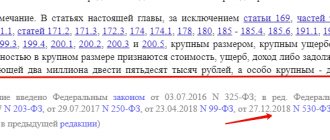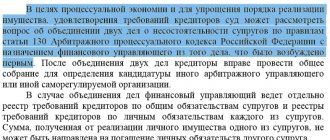Why do people go to extreme measures and break the law?
Economic realities are such that organizations conducting business activities need additional funds. They borrow funds and apply for loans, but not everyone has the opportunity to pay off the resulting debts. The legislation provides for the possibility of completely writing off all debts through bankruptcy proceedings. The bankrupt must apply to the arbitration court and prove his insolvency. The reasons for declaring bankruptcy are:
- delay in payment of debt within 3 months;
- the amount of debt must exceed 300 thousand rubles (500 thousand rubles).
The amount of debt can include not only loan funds, but also tax deductions, debts on supplies, purchases, etc. To get rid of the impending debt, entrepreneurs take such steps as deliberately bringing their business to insolvency or hiding property by any means, so as not to return funds. It is worth distinguishing between fictitious and deliberate bankruptcy, since they have a number of characteristic features and features of the procedure.
Identified signs of bankruptcy entail certain processes and appeals to government agencies, which promise the debtor administrative or criminal liability. Identified violations not only prevent debt closure, but also add obligations to individuals.
Qualification of fictitious bankruptcy in the Code of Administrative Offenses and the Code of Criminal Procedure of Russia
Federal Law of Russia No. 123 and Article 14.12 of the Code of Administrative Offenses qualify fictitious bankruptcy as an illegal act; its description and characteristics are given; the procedure for imposing administrative or criminal liability is indicated.
According to the provisions of the Code of Administrative Offenses and the Code of Criminal Procedure, fictitious bankruptcy is understood as a public statement by an economic entity containing deliberately false information about insolvency; the goal is to deceive creditors and other interested parties about the presence of financial difficulties when they actually do not exist.
Knowingly false information may be disseminated:
- company management;
- Individual entrepreneurs, founders or owner of an enterprise with the right of a legal entity.
The purposes of spreading false information about bankruptcy may be:
- desire to receive a deferment on debt payments;
- refuse to pay debts to creditors;
- close or sell an unprofitable enterprise;
- transfer the business to third parties at a reduced cost;
- withdraw financial and economic assets.
If, as a result of a fictitious bankruptcy, minor financial damage was caused to creditors, the initiator is subject to administrative liability; if major, criminal liability is imposed. A criminal defense lawyer will understand the situation at the enterprise and advise on the course of action to minimize its negative consequences.
Intentional bankruptcy: features and essence
The legislation of the Russian Federation provides for criminal liability for actions or inaction of the debtor that led to insolvency. According to Art. 196 of the Criminal Code of the Russian Federation, if violations of the law were discovered, it is necessary to provide undeniable evidence indicating that the behavior and decisions of the debtor were carried out with the aim of bringing about insolvency. It is also worth distinguishing between the conditions under which a citizen found himself in such a situation or brought a legal entity to insolvency:
- “accidental bankruptcy”: this refers to identified circumstances when the debtor accumulated debt obligations, not realizing that he would not be able to pay, or negligently expected them to be written off.
- intentional: a person intentionally took out loans, accumulated debts, did not pay bills, but hoped that all debts would be written off by the bankruptcy procedure.
These actions provide for criminal liability. The main purpose of deliberate insolvency is to deliberately bring an enterprise to insolvency, tax evasion, and deception of creditors, competitors and partners.
Subjective signs of deliberate bankruptcy
Ulezko Gelyana Sergeevna, master's student at Kaplan University, Brisbane, Australia. Email
The subjective characteristics of any crime include such elements of the crime as the subject and the subjective side. An analysis of the disposition of Article 196 of the Criminal Code of the Russian Federation shows that this crime has a material composition, because To recognize an intentional bankruptcy as completed, major damage must be caused. This description of the objective side of the crime provided for in Article 196 of the Criminal Code of the Russian Federation allows us to assume that the subjective side of the crime is represented by intentional guilt, because the disposition of the article does not indicate reckless guilt. In accordance with Part 2 of Article 24 of the Criminal Code of the Russian Federation, an act committed only through negligence is recognized as a crime only in the case where it is specifically provided for by the relevant article of the Special Part of the Criminal Code. In our case there is no such indication. Moreover, in Article 196 of the Criminal Code of the Russian Federation, the legislator speaks of the commission of actions “knowingly” for the perpetrator leading to the consequences specified in the disposition of the article.
As we indicated earlier, the corpus delicti of this crime is material, therefore intent can be both direct and indirect. Since the disposition of this criminal law norm does not say anything about the motives or goals of this crime, we will not be able to narrow the understanding of the type of intent only to direct intent. Therefore, when committing a crime under Article 196 of the Criminal Code of the Russian Federation with direct intent, the culprit was aware of the social danger of his actions (inaction), entailing the inability of a legal entity or citizen, including an individual entrepreneur, to fully satisfy the demands of creditors for monetary obligations and (or) to fulfill the obligation to make mandatory payments, foresaw the possibility or inevitability of causing major damage and wanted socially dangerous consequences to occur.
By committing a deliberate bankruptcy with indirect intent, the culprit was aware of the social danger of his actions (inaction), entailing the inability of a legal entity or citizen, including an individual entrepreneur, to fully satisfy the claims of creditors for monetary obligations and (or) to fulfill the obligation to pay mandatory payments, foresaw the possibility of socially dangerous consequences, did not want, but consciously allowed the inability of a legal entity or citizen, including an individual entrepreneur, to fully satisfy the claims of creditors for monetary obligations and (or) to fulfill the obligation to pay mandatory payments, the result of which would be causing major damage, or was indifferent to such consequences. In the science of criminal law there is no clear answer to the question: “Is it possible to charge a person with damage actually caused or prevented beyond his will, when at the time of committing actions (inaction) provided for by criminal law, not all creditors were known, nor was the specific amount of obligations known? before creditors and, in particular, does it exceed one and a half million rubles (this is how major damage is defined in the note to Article 169 of the Criminal Code)?
The answer to this question should be yes. But is it correct, as some lawyers do, to argue that since the intent of a person in such circumstances is regarded as uncertain, then the act should be qualified based on the actual size of the consequences that occurred? It seems wrong, since this approach does not solve the problem of criminal liability of a person whose actions are aimed at causing major damage, which, however, did not occur due to circumstances beyond the control of this person. For example, when, in the presence of signs of bankruptcy, the property of a debtor organization in the amount of a smaller amount was alienated by the old manager for next to nothing, but the new manager prevented another negative consequence in the form of causing damage by failing to fulfill obligations to creditors.
Objections to the above position (about the qualification “according to consequences”) are based on the consideration that a certain intent may well be direct. Failure to reflect in a person’s mind the exact number of creditors to whom he does not intend to fulfill obligations, as well as the exact amount of debt, does not exclude the recognition that the specified person acts with direct intent. Such intent should be defined as the desire to cause damage to all possible creditors in an amount not less than that which the manager will be able to “steal away” (conceal, alienate, etc.), thereby creating an obstacle to foreclosure on this property when such recovery is provided for law in order to pay off debts to creditors of the debtor organization.
Accordingly, the act of the leader in such a case should be qualified as an attempted crime, determining the amount of damage to cause which the perpetrator’s intent was directed, based on the value of the hidden and other property that could be subject to foreclosure. If (this is the decision for the above example) when adding (in order to determine the damage as large) the amount of damage caused to the debtor organization with the amounts of unfulfilled obligations, the amount exceeds one million five hundred thousand rubles, then what was done constitutes a crime. “[1] We We fully support the point of view of Yani P.S., supplementing his argument with the fact that the above definition of indirect intent of the crime we are analyzing indicates the indifference of the perpetrator to the consequences. Consequently, the appeal of opponents of the point of view we support to the uncertainty of intent is not entirely appropriate.
A clear understanding of the subjective side of deliberate bankruptcy will help distinguish such crimes from unlawful actions in bankruptcy. Judicial practice experiences difficulties in this matter. Thus, V. was convicted by the court for committing crimes under Art. 196 and part 3 of Art. 30, part 1 art. 195 of the Criminal Code of the Russian Federation, for the fact that as a result of his unlawful actions as the head of Aksai-Inter LLC, an arbitration court introduced a monitoring procedure in relation to the said company. Continuing the implementation of his criminal intentions, V. established Kristall-Yug LLC, into the authorized capital of which he transferred all the fixed assets of Aksai-Inter LLC worth more than 44 million rubles.[2] It seems that V.’s actions should be qualified only under Art. 196 of the Criminal Code of the Russian Federation, because V. consciously created a situation of insolvency. Unlawful actions in bankruptcy are obvious if the situation of insolvency arose under the influence of objective and subjective factors, which was not the case in our case.
Thus, the criterion for distinguishing between unlawful actions in bankruptcy and deliberate bankruptcy is the moment of occurrence of intent to commit actions (inaction) to create insolvency. If before, then the guilty person will be prosecuted under Article 195 of the Criminal Code of the Russian Federation. If after, then according to Art. Art. 196 of the Criminal Code of the Russian Federation as deliberate bankruptcy.
List of cited literature
- Yani P. Problems of qualification of crimes in the field of bankruptcy // Legality. 2014. No. 1. - pp. 38-42.
- Verdict of the Aksai District Court of the Rostov Region in criminal case No. 1-14/2011: Electronic resource https://rospravosudie.com/vidpr-ugolovnoe/court-aksajskij-rajonnyj-sud-rostovskaya-oblast-s/section-acts/ (date requests 03/01/2016)
Definition of fictitious insolvency of an enterprise
In order to deceive creditors, not pay taxes and not return funds, debtors may resort to a solution such as fictitious bankruptcy. This act is also criminally punishable, but only if the citizen independently filed an application with the arbitration court. If a creditor applies or there is no indication that the debtor has deliberately bankrupted, the situation will be treated as an ordinary insolvency case.
The main indicator of fictitious insolvency is the organization's availability of funds necessary to repay debts to creditors. There are situations when funds are stored in different accounts, in different banks or in offshore zones. Despite the complexity of the procedure, the fact of transferring money to such accounts can be verified at the stage of judicial proceedings. It is for the purpose of determining the fictitiousness of transactions and attempts to conceal assets that an analysis of documentation drawn up over a period of up to 2 years is carried out.
Purposes of resorting to fictitious insolvency
The main purpose of fictitious bankruptcy is to gain the opportunity to escape from the “debt trap”. Here you can note contractual obligations with counterparties or creditors, settlements with the budget for taxes and salary payments. Quite often, unscrupulous founders simply do not want to pay the company’s debts and take out bank loans as long as possible.
After the responsible date, the company’s activities are terminated due to the declaration of insolvency. The main goals of such an act can be noted:
- withdrawal of valuable assets;
- release of funds;
- reluctance to inform partners about the real state of affairs in the financial sector;
- attempt to evade tax obligations;
- artificially lowering the value of the company's assets;
- various price frauds.
It is possible to achieve each of the set goals, but usually such actions are easily detected by regulatory organizations and departments, and as a result, established penalties are applied to the violator.
In addition to fraudulent actions on the part of enterprises, fictitious bankruptcy of an individual can be noted. Here, citizens simply want to avoid liability for credit debts or other amounts. A person can be declared bankrupt only if the amount of his debt exceeds 500 thousand rubles, and the period of delay is three months or more.
Additional information on the topic is presented in the video:
Determination by managers of signs of fictitious bankruptcy
At the judicial stage of the bankruptcy procedure, a specialist is appointed - an arbitration manager. It is he who checks the transactions of individuals and legal entities and determines whether there are signs of deliberate and fictitious bankruptcy. If there are any, the manager reports to the authorized bodies about the debtor’s attempt to cheat.
Signs of fictitious bankruptcy:
- purchase of goods necessary for conducting business activities at inflated prices;
- the presence of fictitious credit debts in the documents;
- concealment of part of the property during inspection by auditors;
- settlements with customers are carried out through third parties;
- investing available funds in illiquid securities;
- lack of accounting documentation;
- legal transactions with organizations aimed at transferring capital.
Identified signs of deliberate or fictitious bankruptcy are transferred as evidence to the arbitration court for consideration and a final decision by the leading judge. This conclusion must contain all the necessary conditions that allow you to begin the process of considering the case in an administrative or criminal manner.
Why Use Fictitious Bankruptcy?
As a rule, entrepreneurs who decide on deliberate bankruptcy are concerned about personal interests and strive to obtain the maximum benefit in any situation. Some simply want to avoid obligations and do not want to pay off their debts to lenders, the state, employees, partners and other persons. Other businessmen seek to quickly get rid of an unprofitable business in order to open a new company. There is a category of entrepreneurs who, through bankruptcy, seek to extract personal financial gain without worrying about causing damage to others.
Consequences and liability for willful insolvency
After auditors identify signs of violation of current legislation, they must contact the relevant authorities with a statement. The amount of damage exceeding 1.5 million rubles is grounds for initiating an administrative case. Sanction of Article 14.12. The Code of Administrative Offenses of the Russian Federation provides for a fine of 1 to 3 thousand rubles. However, judicial practice knows few cases with such an amount.
The amount of damage exceeding 1.5 million rubles is grounds for bringing the offender to criminal liability. According to Art. 196 of the Criminal Code of the Russian Federation and 197 of the Criminal Code of the Russian Federation, participants in such a case may face:
- a fine of 200 to 500 thousand rubles, forced labor for up to 5 years, imprisonment for up to 6 years - in case of deliberate bankruptcy;
- a fine of 100 to 300 thousand rubles, forced labor for up to 5 years, imprisonment for up to 6 years - in case of fictitious bankruptcy.
To bring a debtor to justice under the Criminal Code, it is necessary to establish a clear connection between the act and the consequences. The corpus delicti must necessarily include intent or negligence of the head of the company. The process of committing such a crime takes more than one month of work. That is why, in order to determine whether the acts contain elements of a crime, an expert is appointed to monitor and analyze the documentation, accounting and maintenance of all transactions of the debtor.
Identification of fictitious or deliberate bankruptcy for the debtor has only negative consequences: fines, imprisonment, as well as additional monetary obligations.








